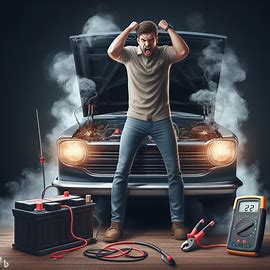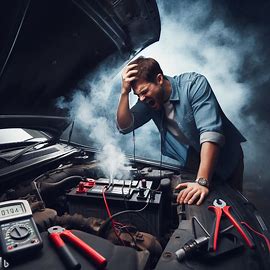In the world of automobiles, there’s nothing quite as perplexing and exasperating as a car that refuses to start. It’s a scenario that can catch you off guard, leaving you stranded and wondering about the root causes. Yet, the good news is that understanding the reasons for a car not starting is the first step towards resolving the issue. Instead of panicking, you can embark on a systematic troubleshooting process to diagnose the problem and possibly fix it yourself. In this guide, we’ll delve into the mysteries of non-starting cars, unraveling the common factors behind this issue and providing insights on how you can troubleshoot and address them effectively.
Key Takeaways
- Dead battery, bad battery terminal/connection, bad alternator, and problem with ignition switch are common reasons for a car not starting.
- Troubleshooting a dead battery involves checking for no dashboard lights or cranking noise, testing headlights and horn, and ruling out dead battery if other electrical components are functioning properly.
- Troubleshooting a bad battery terminal/connection includes checking for loose terminals or rust/dirt accumulation, lack of power transmission to electrical components, and considering battery or wiring connections as potential causes if terminals are clean and secured.
- Troubleshooting a bad alternator involves checking for a car that starts and stalls immediately, dim dashboard/interior lights, and battery warning sign on the dashboard, and ruling out alternator issue if lights are stable and no strange noises are present.

Dead Battery
If you’re experiencing a dead battery, you should check if other electrical components are working properly to rule out any other potential causes. Start by turning on the headlights and testing the horn. If they’re functioning normally, it’s likely that the battery isn’t the issue.
However, if the headlights are dim or the horn is weak, then it’s highly possible that the battery is dead. In such cases, you can try jump-starting the car using jumper cables and a fully charged battery from another vehicle.
If that doesn’t work, you may need to replace the battery altogether. Remember to always take safety precautions when working with car batteries, and if you’re unsure, it’s best to consult a professional mechanic.
Bad Battery Terminal/Connection
You should check both the positive and negative battery terminals, as well as the connection between them, to ensure that they’re clean and secure.
A bad battery terminal or connection can cause your car to not start. Start by inspecting the terminals for any rust or dirt accumulation. If you notice any, clean the terminals using a wire brush or a terminal cleaner.
Make sure the terminals are securely tightened to prevent any power loss. Additionally, check the connection between the terminals to ensure it’s tight and free from any corrosion.
If you find any issues, address them immediately to ensure proper power flow to your car’s electrical components.
Bad Alternator
To fix your car’s bad alternator, you should have it replaced or repaired by a professional mechanic. A bad alternator can cause various issues like a car that starts and stalls immediately, dim dashboard or interior lights, or a battery warning sign on the dashboard. If your lights are stable and there are no strange noises, the alternator may not be the problem.
It’s important to address a bad alternator promptly because it’s responsible for charging the battery and powering the electrical components in your car. Attempting to fix it yourself without the necessary expertise can lead to further damage. Therefore, it’s best to leave it to a professional mechanic who’s the knowledge and tools to properly diagnose and repair the alternator.
Problem With Ignition Switch
You need to check if your car’s lights and horn are still working, as this can indicate a problem with the ignition switch. If your lights and horn aren’t functioning properly, it could mean that the ignition switch isn’t sending power to the electrical components.
To troubleshoot this issue, start by checking if there’s a clicking or strange noise when starting the car. If there’s no noise, it’s likely that the ignition switch isn’t working properly. In such cases, you may need to have the ignition switch inspected and potentially replaced by a professional mechanic.
Key Fob Not Working
Is your key fob not working? Try replacing the battery to see if that resolves the issue. A key fob is a convenient device that allows you to lock, unlock, and even start your car with just a push of a button. However, if the battery in your key fob is low or dead, it may cause it to stop working.
The first step in troubleshooting this problem is to replace the battery with a new one. Make sure to use the correct battery type recommended by your car’s manufacturer. After replacing the battery, test the key fob to see if it’s working properly.
If the issue persists, there may be a different underlying problem with the key fob or the car’s remote entry system, and it’s recommended to consult a professional for further assistance.
Empty Fuel Tank
Check the fuel gauge and ensure that you have enough gas in the tank, as driving with an empty fuel tank can cause your car to stop abruptly. Running out of gas is a common issue that can leave you stranded on the side of the road.
To avoid this inconvenience, always keep an eye on your fuel level and fill up when it gets low. If you find yourself with an empty tank, you can try calling for roadside assistance or walking to the nearest gas station to get a can of gas.
It’s important to remember that driving with an empty fuel tank can’t only be frustrating but also potentially dangerous, so make sure to refuel regularly to keep your car running smoothly.
Troubleshooting and Fixing Car Starting Problems
If your car’s starting problems persist after checking the battery and terminals, it may be necessary to consult a professional mechanic. There could be various reasons why your car isn’t starting, such as a bad alternator, a problem with the ignition switch, or even a key fob that’s not working.
To troubleshoot a dead battery, check if there are no dashboard lights or cranking noise, test the headlights and horn, and ensure that other electrical components are working properly. If the battery isn’t the issue, you may need to consider other possible causes.
Additionally, troubleshooting bad battery terminals or connections involves checking for loose terminals or rust/dirt accumulation, as well as ensuring that there’s proper power transmission to the electrical components. If the issue persists, it’s best to seek professional help to diagnose and fix the problem.
Conclusion
In conclusion, when faced with a car that won’t start, it’s important to stay calm and take a systematic approach to troubleshooting and fixing the issue.
Just like a detective unraveling a mystery, you can uncover the reasons behind the non-starting car and apply the appropriate solutions.
By doing so, you’ll be able to breathe life back into your vehicle and hit the road again, like a phoenix rising from the ashes.
